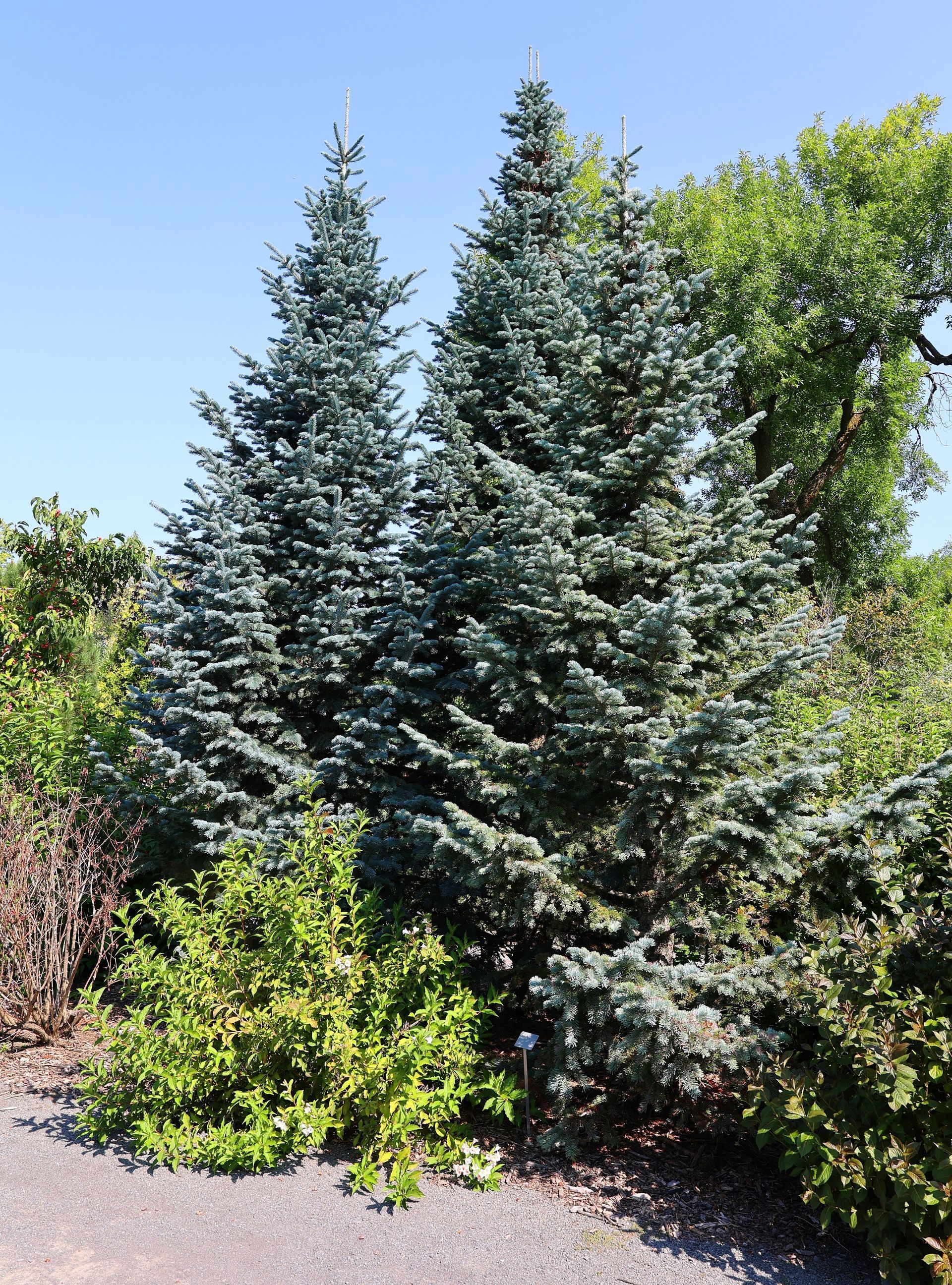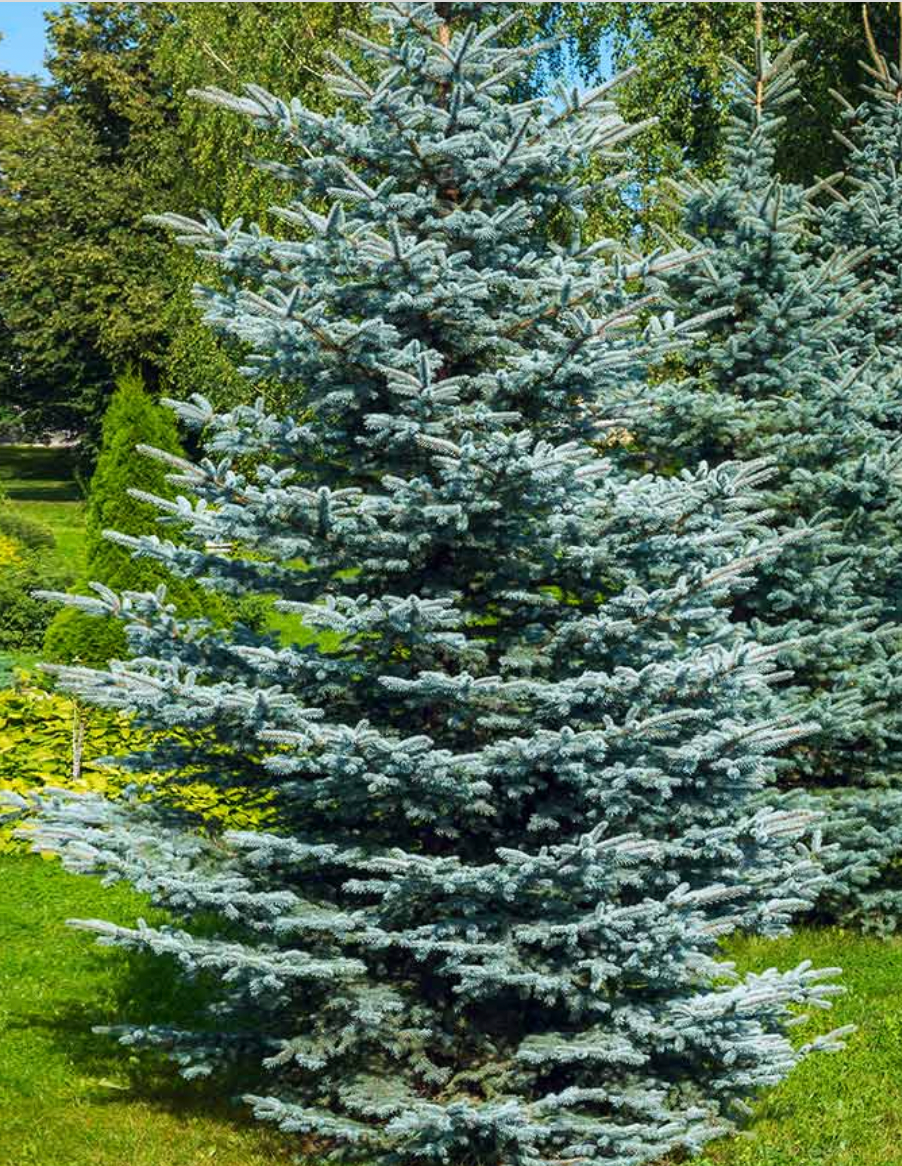Blue Spruce Tree Care Guide

As a member of the pine family, the blue spruce tree is known for its pyramidal form and mature height of 70 to 80 feet. It is a monoecious (plants that produce both male and female reproductive organs) tree with reddish-brown male cones and purple female cones. With proper blue spruce care, you can have this evergreen perennial tree growing in your yard.
Fast Facts for the Blue Spruce Tree
| Common Name | Colorado blue spruce, green spruce, Colorado spruce |
|---|---|
| Scientific Name | Picea pungens |
| Month(s) of Harvest | Light brown cones, 2 to 4 inches in length, mature during the fall |
| Light | Require six hours of daily sun to reach full growth. Although the tree can tolerate partial shade, planting it in a low-light region increases the risk of disease |
| Water | Requires regular watering for the first two seasons but only needs to be watered during dry spells afterward when the roots have established |
| Soil | Prefers rich, well-drained, clay, and acidic soil |
| Fertilizer | The ideal blue spruce fertilizer has a 10-10-10 NPK ratio, although the tree does not require frequent fertilization |
| Pests | Susceptible to attacks by bagworm, balsam twig aphids, bark beetles, gypsy moth, Cooley spruce gall adelgid, eastern spruce gall adelgid, spruce bud scale, spruce spider mite, and white pine weevil |
| Diseases | Affected by tip blights, canker, and needle casts |
| Growing Zone | Zone 2 to 7 |
Table of Contents
How To Take Care of Blue Spruce Trees

The Colorado blue spruce is a coniferous tree with silver-blue foliage, short needles, pyramidal shape, and evergreen habit. Most commonly known for its use as the Christmas tree, the blue spruce belongs to the pine family. Here's what you need to know about blue spruce care.
Soil & Container
You can plant the blue spruce directly in your yard or in a container. When doing the latter, select a pot with adequate drainage holes and use quality potting soil. The tree prefers acidic soil, so you can amend the soil with gypsum and sulfur to achieve the right pH level.
Or, you can plant your Colorado blue spruce tree out in the yard. It requires loamy soil with good drainage. Spruce trees can adapt to clay, sandy, and loamy soils. The soil's pH should be between 6 and 7.5.
Root Inspection
Blue spruce trees grow at a rate of 12" to 24" per year. In five years, a blue spruce tree can reach a height of 5 feet. Established trees take up a lot of space in your yard since they have a spread of 10 to 25 feet.
When the blue spruce tree is big enough, you need to transplant it from the pot to the soil. Make sure you plant the tree at least 25 feet from your house, or the nearby structures will obstruct the tree's growth.
Inspect the tree's root ball before transplanting. Wash the root ball with a hose and look for damaged, circling, and broken roots. Remove the broken roots from the root ball and change the direction of the circling roots so that they grow outward.
Water Requirements
The blue spruce tree does not have extensive watering needs. In the first two seasons of its growth, you should water the tree regularly. Established trees only need to be watered during dry periods. Consistently moist soil can result in fungal diseases and root rot.
Since blue spruce trees are drought-tolerant, they can grow well in regions with low rainfall.
Fertilizing and Filling
Although blue spruce trees do not require frequent fertilization, adding a 10-10-10 fertilizer in early spring can give the tree a nutrition boost. A fertilizer can increase the tree's size and improve its needles' color.
A 10-10-10 fertilizer will have 10% of nitrogen, phosphorus, and potassium each, which is enough for blue spruce. Sprinkle a slow-release fertilizer at the root zone of the blue spruce and water the area with 2 inches of water to avoid fertilizer burn.
Follow the instructions on the fertilizer label to determine the amount. Alternatively, you can use natural fertilizers, such as alfalfa meal, fish emulsion, cottonseed meal, and compost. These prevent fertilizer burn, which can happen when you add too much synthetic fertilizer.
Sun & Placement
The blue spruce needs six hours of full sun per day. Place your Colorado blue spruce tree in a sunny spot that also has protection from the wind.
Temperature and Humidity
Blue spruce trees are more sensitive to daytime temperatures, ranging between 13° and 31° C (55° and 88° F). Meanwhile, they can better tolerate night temperatures in the range of 7° and 25° C (45° and 77° F) (86).
The tree cannot survive in hot temperatures since the needles turn brown and die. However, it can still tolerate more humidity than other spruce varieties.
Pruning
Prune your blue spruce trees in early spring or late winter when the tree still has a long time ahead for optimal growth. Follow these steps to prune a blue spruce tree:
- Cut the side branches that are distorting the tree's regular conical shape.
- Do not prune mature and thick branches, as it will spoil the tree's overall appearance. The only exception to this rule is if you want to raise the tree's crown. Then, you can trim the lower branches.
- Remove the diseased and dead branches throughout the year. Make sure you cut as close to the trunk as possible.
- If the top branch is quite long, shorten it a bit. But do not take away more than half its height. Leave some buds on it.
When pruning Colorado blue spruce, you should also be considerate about aftercare. Only use sharp tools for pruning, or the wounds will take too long to heal. Sterilize the tools between cutting so that any pest infestation does not spread from the diseased branches to the healthy limbs.
Shears and bypass pruners are enough in most cases. But if you need to raise the crown, you'll need to cut thick branches, which requires using loppers and a saw.
Do not water your blue spruce tree for a day or two after pruning. Moist wounds can become entry points for fungi and insects. In a few days, the tree will release resin to cover its wounds.
Did You Know? The Colorado blue spruce is a deer-resistant tree. That means deer won't eat it. Deer-resistant trees have a certain texture, smell, or flavor that keeps deer from feeding on them.
Common Blue Spruce Tree Care Problems
Blue spruce trees are susceptible to several plant diseases that can disrupt their healthy growth and cone production. If you notice the following signs, your tree might be unhealthy.
Scattered Branch Dieback
Branch dieback means that some parts of the tree have died due to a disease. The affected branches may look discolored and dry, with no healthy buds.
Spruce trees with scattered branch dieback, especially on the lower branches, have been infected by Cytospora fungus. The fungal species forms cankers on different hardwood trees and conifers.
Tree wounds and branch stubs provide the entryway for Cytospora fungus. With time, the fungus girdles and encircles the branches, killing them. You will notice light brown needles on the dead branches. These needles fall off the tree over time, leaving the branches bare.
Prevention is the best approach for cankers. You should plant blue spruce trees in well-drained soil. Put mulch around the tree to improve its growth and reduce competition from weeds, such as turfgrass.
Also, prune the diseased branches. Prune around 4 to 6 inches below the canker to minimize the spread of this fungal disease.
Purple or Brown Needles
Rhizosphaera Needle Cast is the reason for blue spruce tree needles turning purple and brown. In the first year, the disease affects the lower branches. By the second year, it progresses to the top of the tree, making the needles turn brown and fall off the tree.
Besides discoloration, black spots also form on the needles. These are fungal fruiting structures that contain spores, which are responsible for spreading the disease to other branches.
Rhizosphaera spreads over winter by dripping and splashing water. If you notice the aforementioned symptoms, do the following:
- Spray a fungicide onto the spruce tree in the last two weeks of May.
- Spray again 4 to 6 weeks later.
- Follow the instructions on the fungicide packaging to determine how much fungicide you need to spray.
The following fungicides are labeled for treating needle cast: Daconil 2787, Daconil Ultrex, Manicure Flowable, Terranil 90, Thalonil 4L, Thalonil 90, and Twosome Flowable.
Weakened Tree
If your spruce tree is overall weaker, exhibiting symptoms like declining health, yellowing needles, and branch dieback, it may be infested by a pest. An example is the Spruce bud scale (Physokermes hemicryphus), which is reddish-brown and globular. These insects gather in a cluster of 3 to 8 at the base of new tigs. They mostly infect the lower branches of the spruce tree.
Several bark beetles, such as Ips spp, also infect the blue spruce trees. These beetles are attracted to spruce trees stressed by site characteristics or drought.
Another pest that infects the blue spruce tree is the white pine weevil (Pissodes strobi), which chews holes close to the terminal buds. These insects lay eggs in the chewed holes. As they grow, the larvae cause dieback and stunted growth.
Learning About Blue Spruce Trees
The blue spruce is the state tree of Colorado, which is where it gets its common name from. It has several varieties, such as the following:
- Baby Blue Eyes: The semi-dwarf cultivar grows about 15 to 20 feet tall and has the same silvery-blue needles as the taller cultivars.
- Bakeri: The cultivar grows up to 20 feet and has deep blue needles.
- Glauca Globosa: It's a dwarf variety that grows only 5 to 6 feet wide.
- Moerheimii: The cultivar has droopy branches and grows up to 30 feet tall.
- Montgomery: This is another semi-dwarf cultivar that grows up to 6 feet.
Regardless of the cultivar, you can grow a new blue spruce from the seed. For that, you have to collect the pinecones, dry them, and then remove the seeds. Here's how to do it:
- Soak the seeds from the pine cone in water for 24 hours in spring.
- Take the seeds out of the water and wrap them in a moist paper towel.
- Store the paper towel-wrapped seeds in your refrigerator for up to six weeks.
- Plant these seeds in a moist seed-starting mix.
- Cover the seeds with 1/4 inch of this mixture and put plastic wrap on the pot.
- Put the pot in a sunny place. Make sure the mixture is moist until seed germination.
- Take the plastic wrap of the pot when the tap root grows about an inch.
- Put the pot in direct sunlight, minus the plastic wrap, for a few days to harden the seed.
- Plant the seed into the ground and put mulch around the base.
- Water the spot for up to three years regularly.
Colorado Blue Spruce Tree Origin Story
The blue spruce tree is native to the central Rocky Mountains. Apart from Colorado, it has been planted in landscapes and shelterbelts of Nebraska. The tree is also found in other areas across North America, including Utah, Wyoming, Idaho, Arizona, and New Mexico.
Blue spruce is a long-lasting tree that can survive for up to 600 years. However, the trunk diameter grows slowly. A tree with a diameter of 4 to 5 inches is about 125 to 135 years old, while that with a 22-inch diameter may be up to 350 years old.
Sweet New Earth's Final Word On Blue Spruce Trees
Knowing blue spruce care means you can grow a Christmas tree in your backyard. It's one of the best front yard trees. The best part about blue spruce trees is that they are long-lived and act as privacy trees or sturdy windbreaks. Most trees can live for about 200 years in domestic settings, while others grow for six centuries.
Many people worry about the mess spruce needles can create in their yards or garden. But the Colorado blue spruce does not shed its needles in the fall. You may see an occasional needle drop, but that's about it.
As long as you select the right planting soil, offer direct sunlight and partial shade, and fertilize the tree before the growing season, the blue spruce will continue growing for about 1 to 2 inches yearly.

Christina Hernandez
Christina has done most of her research on environmental science but recently has changed her focus towards sustainable forestry. She has a passion for the outdoors and wants to spread that passion to the world.
Join our community!
Join to receive guides, insights, and the latest gardening deals!
